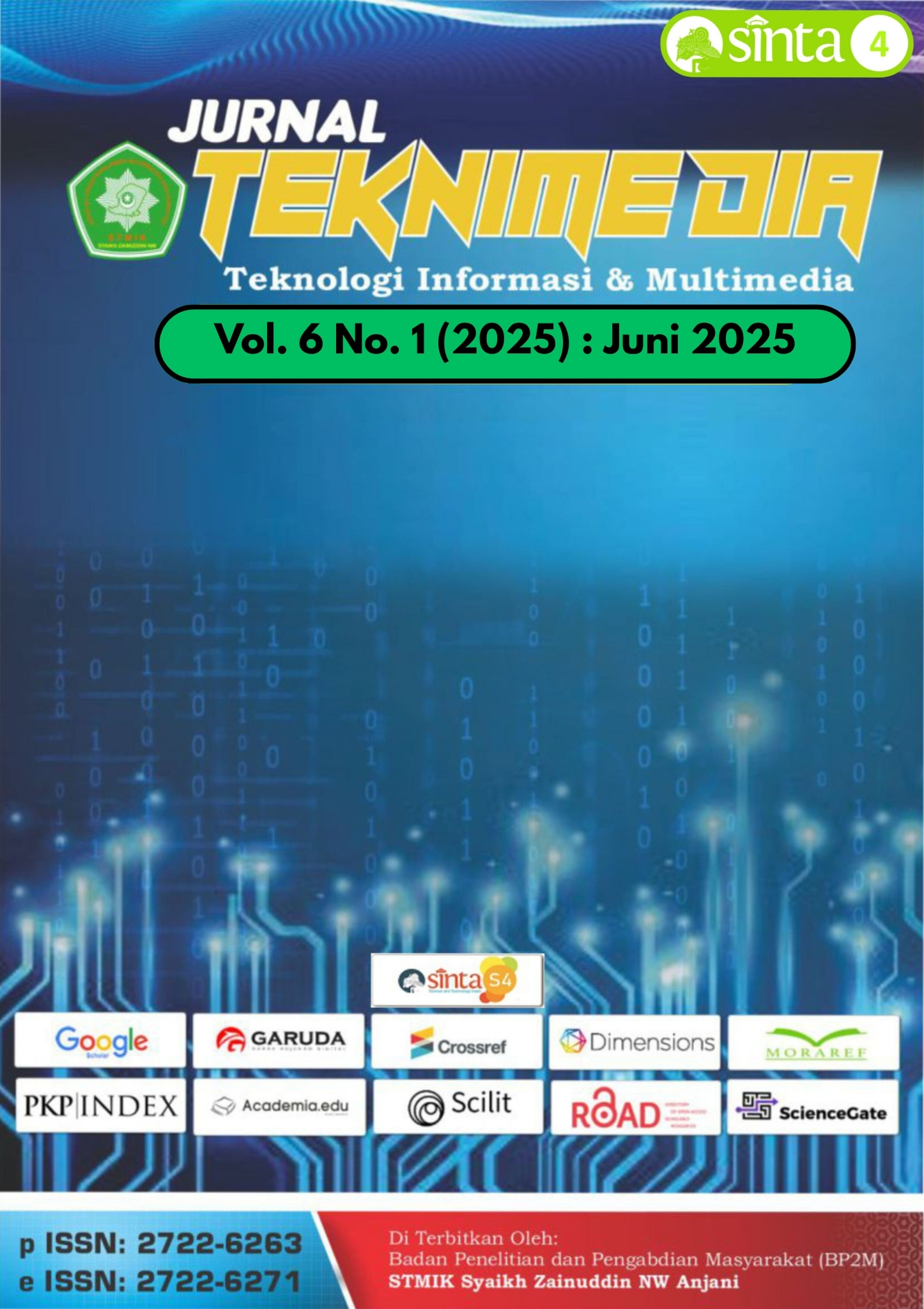IMPLEMENTASI SISTEM ABSENSI BIOMETRIK MAHASISWA TERINTEGRASI DATA KEHADIRAN SIMAK DOSEN MENGGUNAKAN MIKROKONTROLER ESP32
Abstrak
Attendance is one of the important aspects of human resource management in various institutions, whether in the educational environment, companies, or government agencies. Biometrics is a technology used to identify or verify a person's identity based on unique physical or behavioral characteristics. The system development method used in this research is the prototype method. This research produces a biometric attendance tool using the ESP32 microcontroller integrated with the Simak system for UM Kendari, which can then be implemented according to its function. With the presence of this biometric attendance tool, it is hoped that it can minimize any potential cheating that may occur in the lecture attendance process and make it easier for lecturers to manage student attendance. The results of the testing of this biometric attendance system and tool were successfully conducted, marked by the tool functioning well and the system being able to integrate with the lecturer's Simak. The fingerprint testing of students was conducted on 30 people with an average of 3 trials each, where 27 people were successfully detected and the remaining 3 failed to be detected due to the condition of the students' fingers being injured.
Referensi
[2] I. Wibawa, “Imam Wibawa, 2014 Pengaruh Penggunaan Media Rekaman Time Lapse Terhadap Peningkatan Hasil Belajar Ranah Kognitif Dan Aktivitas Belajar Siswa Pada Mata Pelajaran IPA Universitas Pendidikan Indonesia | repository.upi.edu | perpustakaan.upi.edu,” no. 2013, pp. 1–14, 2014.
[3] Z. Reno Sputra Elsi, “Rancang Bangun Absensi Perkulihan Dengan Fingerprint Berbasi Webbase Design of Education Absention With Web Based Fingerprint,” J. Sist. Komput. Musirawas, vol. Vol 05, no. No 01, pp. 24–32, 2020.
[4] E. Simonna, “Perancangan Sistem Absensi Menggunakan Finger Print,” vol. 1, pp. 105–112, 2019, [Online]. Available: http://repo.darmajaya.ac.id/3114/16/%2816%29 BAB 2.pdf
[5] K. L. Damayanthi, I. M. Putra, and P. B. Suyasa, “Rancang Bangun Sistem Daftar Hadir Berbasis Fingerprint dengan ARDUINO UNO,” J. Jis Siwirabuda, vol. 1, no. 2, pp. 97–108, 2023.
[6] M. F. P. Ryanda, “RANCANG BANGUN SISTEM ABSENSI BIOMETRIC MENGGUNAKAN SENSOR FINGERPRINT AS608 BERBASIS MIKROKONTROLLER ARDUINO UNO DAN MICROSOFT EXCEL,” Int. J. Technol., vol. 47, no. 1, p. 100950, 2023, [Online]. Available: https://doi.org/10.1016/j.tranpol.2019.01.002%0Ahttps://doi.org/10.1016/j.cstp.2023.100950%0Ahttps://doi.org/10.1016/j.geoforum.2021.04.007%0Ahttps://doi.org/10.1016/j.trd.2021.102816%0Ahttps://doi.org/10.1016/j.tra.2020.03.015%0Ahttps://doi.org/10.1016/j
[7] S. Chau, J. Banjarnahor, D. Irfansyah, S. Kumala, and J. Banjarnahor, “Analysis of Face Pattern Detection Using the Haar-Like Feature Method,” J. Inf. Technol. Educ. Res., vol. 2, no. 2, pp. 70–76, 2019, doi: 10.31289/jite.v2i2.2133.
[8] F. S. B. Karo, “Analisis Penerimaan Nasabah Bank Syariah Indonesia Dalam Implementasi Teknologi Biometrik Pada Mobile Banking Di Aceh,” UNIVERSITAS ISLAM NEGERI AR-RANIRY BANDA ACEH, 2024.
[9] M. Pauzan and I. Yanti, “Sistem Absensi Fingerprint Berbasis Arduino dengan Data Penyimpanan di Micro SD,” Gema Wiralodra, vol. 13, no. 2, pp. 663–679, 2022, doi: 10.31943/gemawiralodra.v13i2.273.
[10] A. Siswanto, A. Efendi, and A. Yulianti, “Alat Kontrol Akses Pintu Rumah Dengan Teknologi Sidik Jari Di Lingkungan Rumah Pintar Dengan Data Yang Di Enkripsi,” J. Penelit. Pos dan Inform., vol. 8, no. 2, p. 97, 2018, doi: 10.17933/jppi.2018.080201.
[11] H. Kusumah and R. A. Pradana, “Penerapan Trainer Interfacing Mikrokontroler Dan Internet of Things Berbasis Esp32 Pada Mata Kuliah Interfacing,” J. CERITA, vol. 5, no. 2, pp. 120–134, 2019, doi: 10.33050/cerita.v5i2.237.
[12] A. Z. dan D. Yusri, “Rancang Bangun Akses Ruangan Dengan Teknologi (Biometrik) Sidik Jari Berbai Web,” J. Ilmu Pendidik., vol. 7, no. 2, pp. 809–820, 2020.
[13] Haris Tri Saputra, Abdi Muhaimin, and Bambang Kurniawan, “Sistem Kontrol Kunci Pintu Rumah Menggunakan Fingerprint Smartphone Android Berbasis Arduino Uno,” J. Ilmu Komput., vol. 11, no. 1, pp. 5–9, 2022, doi: 10.33060/jik/2022/vol11.iss1.239.
[14] D. Yeniwati, Riswan, Nilawati, and Trigina, “Sistem Absensi Siswa Menggunakan Fingerprint Berbasis Arduino Mega 2560,” FORTECH (Journal Inf. Technol., vol. 6, no. 1, pp. 26–31, 2022, doi: 10.53564/fortech.v6i1.874.
[15] A. A. Fingerprints, “Pembuatan Aplikasi Presensi Perkuliahan Berbasis Fingerprint,” vol. 2, no. 3, 2013.
[16] K. Kurniati, “Penerapan Metode Prototype Pada Perancangan Sistem Pengarsipan Dokumen Kantor Kecamatan Lais,” J. Softw. Eng. Ampera, vol. 2, no. 1, pp. 16–27, 2021, doi: 10.51519/journalsea.v2i1.89.
[17] E. Meilinda, R. Sabaruddin, and D. Fitriani, “Model Prototype Sebagai Metode Pengembangan Perangkat Lunak Pada Sistem Informasi Pengaduan Umum (Studi Kasus : Dinas Perhubungan Provinsi Kalimantan Barat),” J. Khatulistiwa Inform., vol. 9, no. 2, pp. 86–91, 2021, doi: 10.31294/jki.v9i2.11753.
[18] D. Purnomo, “Model Prototyping,” JIMP-Jurnal Inform. Merdeka Pasuruan, vol. 2, no. 2, pp. 54–61, 2017.
##submission.copyrightStatement##
##submission.license.cc.by-sa4.footer##Semua tulisan pada jurnal ini menjadi tanggungjawab penuh penulis. Jurnal Teknimedia memberikan akses terbuka terhadap siapapun agar informasi dan temuan pada artikel tersebut bermanfaat bagi semua orang. Jurnal Teknimedia dapat diakses dan diunduh secara gratis, tanpa dipungut biaya, sesuai dengan lisensi creative commons yang digunakan.

Jurnal TEKNIMEDIA : Teknologi Informasi dan Multimedia is licensed under a Lisensi Creative Commons Atribusi-BerbagiSerupa 4.0 Internasional


.png)





